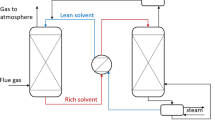Abstract
Objectives
To engineer a recombinant Escherichia coli to produce polyhydroxyalkanoate biopolymer beads displaying carbonic anhydrase (CA) from Desulfovibrio vulgaris str. “Miyazaki F” (DvCA).
Results
The highest measured specific activity of the immobilised CA was 211 U/mg DvCA. The immobilised CA was thermostable, retaining 114 U/mg DvCA of activity after incubation at 90 °C for 1 h. Additionally, the immobilised CA tolerated 30 min incubations in a variety of pH conditions and was especially tolerant of alkaline conditions, retaining 131 U/mg DvCA of activity after pH 12 incubation.
Conclusion
CA has a potential role in atmospheric CO2 mitigation strategies and the stability of the functionalised beads indicates suitability for use in industrial settings such as coal-fired power plants.




Similar content being viewed by others
References
Alvizo O, Benoit M, Fusman I, et al. (2011) Highly stable β-class carbonic anhydrases useful in carbon capture systems. US Patent 8,354,261
Amara AA, Rehm BHA (2003) Replacement of the catalytic nucleophile cysteine-296 by serine in class II polyhydroxyalkanoate synthase from Pseudomonas aeruginosa-mediated synthesis of a new polyester: identification of catalytic residues. Biochem J 374:413–421
Atwood JA, Rehm BHA (2009) Protein engineering towards biotechnological production of bifunctional polyester beads. Biotechnol Lett 31:131–137
Blatchford PA, Scott C, French N, Rehm BHA (2012) Immobilization of organophosphohydrolase OpdA from Agrobacterium radiobacter by overproduction at the surface of polyester inclusions inside engineered Escherichia coli. Biotechnol Bioeng 109:1101–1108
Brandl H, Gross RA, Lenz RW, Fuller RC (1988) Pseudomonas oleovorans as a source of poly(beta-hydroxyalkanoates) for potential applications as biodegradable polyesters. Appl Environ Microbiol 54:1977–1982
Brockelbank JA, Peters V, Rehm BHA (2006) Recombinant Escherichia coli strain produces a ZZ domain displaying biopolyester granules suitable for immunoglobulin G purification. Appl Environ Microbiol 72:7394–7397
Chien L-J, Sureshkumar M, Hsieh H-H, Wang J-L (2013) Biosequestration of carbon dioxide using a silicified carbonic anhydrase catalyst. Biotechnol Bioproc Eng 18:567–574
Draper J, Du J, Hooks DO et al (2013) Polyhydroxyalkanoate inclusions: polymer synthesis, self-assembly, and display technology. In: Rehm BHA (ed) Bionanotechnology biological self-assembly and its applications. Caister Academic Press, Norfolk, pp 1–36
Gonz JM, Zo S (2014) Carbonic anhydrase: mechanism, regulation, links to disease, and industrial applications, vol 75. Springer, Heidelberg, pp 405–426
Grage K, Jahns AC, Parlane N, Palanisamy R, Rasiah IA, Atwood JA, Rehm BHA (2009) Polyhydroxyalkanoate granules: biogenesis, structure and potential use as micro-/nano-beads in biotechnological and biomedical applications. Biomacromolecules 10:660–669
Hooks DO, Blatchford PA, Rehm BHA (2013) Bioengineering of bacterial polymer inclusions catalyzing the synthesis of N-acetylneuraminic acid. Appl Environ Microbiol 79:3116–3121
Huesemann MH (2006) Can advances in science and technology prevent global warming? Mitig Adapt Strateg Glob Chang 11:539–577
Jahns AC, Rehm BHA (2014) Immobilization of active lipase B from Candida antarctica on the surface of polyhydroxyalkanoate inclusions. Biotechnol Lett. doi:10.1007/s10529-014-1735-7
Lindskog S (1997) Structure and mechanism of carbonic anhydrase. Pharmacol Ther 74:1–20
Rehm BHA (2006) Genetics and biochemistry of polyhydroxyalkanoate granule self-assembly: the key role of polyester synthases. Biotechnol Lett 28:207–213
Rehm BHA, Steinbüchel A (1999) Biochemical and genetic analysis of PHA synthases and other proteins required for PHA synthesis. Int J Biol Macromol 25:3–19
Venning-Slater M, Hooks DO, Rehm BHA (2014) In vivo self-assembly of stable green fluorescent protein fusion particles and their uses in enzyme immobilization. Appl Environ Microbiol 80:3062–3071
Acknowledgments
This study was funded by Institute of Fundamental Sciences (Massey University) and the MacDiarmid Institute. DOH received funding from the Institute of Fundamental Sciences at Massey University and a Massey University PhD scholarship.
Supplementary information
Supplementary Table 1—Point mutations in the enhanced Desulfovibrio vulgaris str. “Miyazaki F” carbonic anhydrase.
Supplementary Table 2—Tryptic peptides of PhaC fusion proteins as identified by MALDI-TOF/TOF MS. Total bead protein was electrophoresed onto a gel and a band corresponding to the theoretical molecular weight of the fusion protein was isolated and analysed by mass spectrometry.
Supplementary Fig. 1—PHB content of Escherichia coli BL21 blue cells as measured by GC/MS. Cells contained either PhaC or PhaC-fusion expression plasmids and were cultivated for 48 h at 25 °C after induction with isopropyl-β-D-1-thiogalactopyranoside.
Author information
Authors and Affiliations
Corresponding author
Electronic supplementary material
Below is the link to the electronic supplementary material.
Rights and permissions
About this article
Cite this article
Hooks, D.O., Rehm, B.H.A. Surface display of highly-stable Desulfovibrio vulgaris carbonic anhydrase on polyester beads for CO2 capture. Biotechnol Lett 37, 1415–1420 (2015). https://doi.org/10.1007/s10529-015-1803-7
Received:
Accepted:
Published:
Issue Date:
DOI: https://doi.org/10.1007/s10529-015-1803-7




